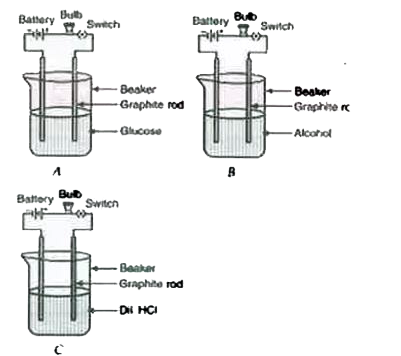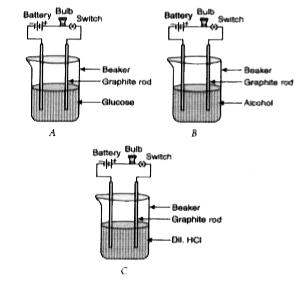Observe the following set up :

(a) Which of the bulb glows ?
(b) Give reason for each of the case.
(c ) What would be the change observed if the content of the beaker B is replaced by NaOH solution ?Solution in Kannada
(a) Bolb C
(b) Glucose and alcohol do not dissociate ions when dissolved in water as they are covalent compounds. As there is no movement of ions, bulb does not glow. HCl being an acid, releases H+ when dissolved in water thereby helps in conducting electricity. Hence the bulb glows.
(c ) If beaker B is replaced by NaOH solution, the bulb glows. This is because NaOH being a base, releases OH - ions to the solution which conducts electricity.
Topper's Solved these Questions
- BOOK - ZEN PUBLICATIONCHAPTER - ACIDS, BASES, AND SALTSEXERCISE - ZEN ADDITOINAL QUESTIONS SECTIONS (Long Answer Type Questions)21videos
ACIDS, BASES, AND SALTS
- BOOK - ZEN PUBLICATIONCHAPTER - ACIDS, BASES, AND SALTSEXERCISE - ZEN ADDITOINAL QUESTIONS SECTIONS (Short Answer Type Questions - I)26videos
ACIDS, BASES, AND SALTS
- BOOK - ZEN PUBLICATIONCHAPTER - CARBON AND ITS COMPOUNDS EXERCISE - ACTIVITY2videos
CARBON AND ITS COMPOUNDS
Similar Questions
Name the substance that is produced from baking soda and is used in the removal of permanent hardness of water.
04:37View SolutionHow does the pH affects the curdlling of milk ?
02:46View Solutiontake some carbon compounds ( naphthalene , camphor , alcohol ) one by one on a spatula and burn them
* observe the nature of the flame and note whether smoke is produced
* place a metal plate above the flame . Is there a deposition on the plate in case of any of the compounds ?02:37View SolutionPure water is added into the following solution causing a 10% increase in volume of each. The greatest percentage change in pH would be observed in which case (a),(b),( c), or (d) ?
01:24View SolutionThe mean of a set of observation is a. If each observation is multiplied by b and each product is decreased by c, then the mean of new set of observations is ______.
View SolutionThe mean of a set of observations is a . If each observation is multiplied by b and each product is decreased by c, then the mean of new set of observations is
03:56View SolutionBlue litmus solution is added to two test tubes A and B containing dilute HCl and NaOH
solution respectively. In which test tube a colour change will be observed? State the
colour change and give its reason.03:34View SolutionThree beakers labelled as A, B and C each containing 25 mL of water were taken. A small amount of NaOH, anhydrous CuSO4 and NaCl were added to the beakers A, B and C respectively. It was observed that there was an increase in the temperature of the solutions contained in beakers A and B, whereas in case of beaker C, the temperature of the solution falls. Which one of the following statement(s) is (are) correct ?
(i) In beakers A and B, exothermic process has occurred.
(ii) In beakers A and B, endothermic process has occurred.
(iii) In beaker C exothermic process has occurred.
(iv) In beaker C endothermic process has occurred.View SolutionBlue litmus solution is added to two test tubes A and B containing dilute HCl and NaOH solution respectively. In which test tube a color change will be observed? State the colour change and give its reason.
04:01View SolutionThe bulb does not glow in the set up show in figure. List the possible reasons.
03:07View SolutionA student takes three beakers A,B and C filled with aqueous solution of glucose, alcohol and hydrochloric acid respectively as shown in the following figure.

(i) State your observations in terms of glowing of bulb when the switch is on.
(ii) Justify your observations by giving reason in each case.
(iii) Mention the change noticed with appropriate reason if the content of beaker B is replaced by sodium hydroxide solution.03:54View SolutionThree different elctrolytic cells A, B and C are connected in separate circuits .Electrolytic cell A contains sodium chloride solution. When the circuit is complete . A bulb in the circuit glows brightly .electrolytic cell B contains acetic acid solution and in this case the bulb in the circuit glows dimly . The elctrolytic cell C contains sugar solution and the bulb does not glow . Give a reason for each of these observations .
02:28View SolutionThree different electrolytic cells A, B and C are connected in separate circuits. Electrolytic cell A contains sodium chloride solution. When the circuit is completed, a bulb in the circuit glows brightly. Electrolytic cell B contains acetic acid solution and in this case the bulb in the circuit glows dimly. The electrolytic cell C contains sugаr solution and the bulb does not glow. Give a reason for each of these observations.
01:18View SolutionStudy the set-up shown in the diagram and answer the following: What change will you observe in part 'B' of the setup after one hour? Give reason for this change.
03:25View SolutionIn the following figures, the bulbs in Figure A and D glow, but the bulbs in Figure B and C do not glow. Give reason.
03:26View Solution

